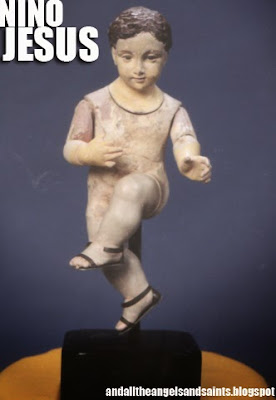IMMACULATE TRANSACTION. This spectacular Immaculate Conception of over 3 feet, appeared for sale on ebay from dealer "robacus" or "losantiguos", who was allegedly involved in church theft sometime in 2003-04.. The case was later dismissed.
This spread of fabulous santos appeared on the ebay page of Rory Bacus, who sold antique santos under the name "robacus" and "losantiguos". After some objects were found in his house, the Cebu archdiocese sued the dealer for fencing various religious artifacts in October 2003.
In April of the next year, a decision was handed down by the Cebu Regional Trial Court dismissing the case against Bacus.
Regional Trial Court Judge Ireneo Lee Gako Jr., in a Feb. 20 order, exonerated Bacus of the charges of violating the Anti-Fencing Law. The court also ordered the release of 278 religious icons and artifacts to Bacus.
The dismissal of the case greatly disappointed Church officials who expressed their disgust over the outcome of the case. Fr. Carlito Pono, head of the Commission on the Cultural Heritage of the Church, admitted that while some of the parishes that reportedly lost icons had refused to cooperate, others could not find any evidence to prove ownership of the stolen items.
While the case was dragging, Bacus returned to eba, although this time around, his posted items were smaller, primitive santos--the kinds one can readily find in downtown Manila antique shops.
Ninos, such as these, obviously carried by bigger santo figures like San Antonio, Virgen del Rosario, etc. were also listed on ebay. Some were sold, others withdrawn for sale even after a winning bid had been placed. The dealer sent explanatory messages to the effect that the item had been sold in an antique fair and that he had forgotten.
The noted antique dealer, Rory Bacus, passed away, sometime in 2013. The whereabouts of his remaining antique santo stock remains unknown.














